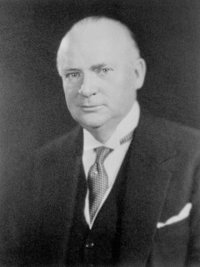Richard Bedford Bennett, 1st Viscount Bennett
|
|
- For the British composer named Richard Bennett, see Richard Rodney Bennett.
| Rank: | 11th |
| Date of Birth: | July 3, 1870 |
| Place of Birth: | Hopewell Hill, New Brunswick |
| Spouse: | never married |
| Profession: | lawyer |
| Political Party: | Conservative |
Richard Bedford Bennett (July 3, 1870 – June 26, 1947) was the eleventh Prime Minister of Canada from August 7, 1930 to October 23, 1935.
He was born in Hopewell Hill, New Brunswick, Canada, and studied at Dalhousie University, graduating in 1893 with a law degree. Bennett spent time as a school teacher, principal, lawyer and businessman before entering local politics. Before moving to Alberta, he was a partner in a law firm in Chatham, New Brunswick. Max Aitken, later, Lord Beaverbrook, was his office boy.
In 1905, Bennett became the first leader of the Alberta Conservative Party and, in 1909, won a seat in the provincial legislature before switching to federal politics.
He was elected to the Canadian House of Commons in 1911, was appointed Minister of Finance in 1926 and became Conservative leader in 1927 at the first Conservative leadership convention.
He was elected Prime Minister of Canada in 1930, defeating William Lyon Mackenzie King, just when the worst depression of the century was hitting the country. Bennett tried to fight the depression by expanding trade within the British Empire and imposing tariffs for imports from outside the Empire promising that his measures would blast Canadian exports into world markets, but his success was limited, and his impersonal style and reputation for wealth alienated many struggling Canadians.
When his imperial preference policy failed to generate the desired result Bennett's government had no alternatives. The party's pro-business, pro-bank inclinations provided no relief to the millions of unemployed who were now becoming increasingly desperate and agitated. The Conservatives seemed indecisive and unable to cope and rapidly lost the confidence of Canadians becoming a focus of hatred, ridicule and contempt. Car owners who could no longer afford gasoline reverted to having their vehicles pulled by horses and dubbed them Bennett buggies.
R. B. Bennett faced pressure for radical reforms from within and without the party. The Cooperative Commonwealth Federation, formed in 1932, prepared to fight its first election on a socialist program; the Social Credit movement was gaining supporters in the west and shocked the country by winning the Alberta provincial election and forming government in September, 1935; Bennett's own government suffered a defection as his Trade minister, Henry Herbert Stevens, left the Conservatives to form the Reconstruction Party of Canada when Bennett refused to enact Stevens' plans for drastic economic reform and government intervention in the economy to deal with the crisis.
Reacting to fears of communist subversion, Bennett used the controversial Section 98 of the Canadian Criminal Code. That section allowed for the imprisonment of anyone who was a member of an organization that officially advocated the violent overthrow of the government, even if the accused had never committed an act of violence or even personally supported such an action. With this law, the leaders of the Communist Party of Canada, including Tim Buck were arrested and imprisioned for sedition. However, this action proved to be a damaging embarrassment for the government, especially when Buck was the victim of an apparent assassination attempt when he was shot at when he was confined to his cell during a prison riot, despite the fact he was not participating in any way. Bennett's government was forced to admit that they ordered the shooting, allegedly only to scare Buck. Regardless, Bennett's case against Buck lost all credibility and ultimately backfired as Buck was soon released and feted as a hero.
Bennett attempted to prevent social disorder by evacuating the unemployed to relief camps far away from the cities but this only exacerbated social tensions leading to the On to Ottawa Trek of unemployed protesters who intended to ride the rails from Vancouver to Ottawa (gathering new members along the way) in order to bring their demands for relief to Bennett personally. The trek ended in Regina on July 1, 1935 when the RCMP, on orders from the Prime Minister and Minister of Justice Hugh Guthrie, attacked a public meeting of 3,000 strikers leaving one dead and dozens injured.
Following some of the New Deal policies of United States President Franklin D. Roosevelt Bennett changed tactics, introducing his "New Deal" of public spending and federal intervention in the economy. Bennett proposed progressive income taxation, a minimum wage, a maximum for work week hours, unemployment insurance, health insurance, an expanded pension program and grants to farmers but the Conservative's conversion to the concept of a welfare state was too little too late and the Tories were routed in the October 1935 election winning only 40 seats to 173 for Mackenzie King's Liberals.
Richard Bennett retired to Britain in 1938 and, in 1941, became the first, and only, former Canadian Prime Minister to be elevated to the British House of Lords (as Viscount Bennett).
He died on June 26, 1947 at Mickleham, England, and is buried in St. Michael's Churchyard, Mickleham, Surrey, England. He is the only former Prime Minister not buried in Canada.
External links
- Biography at the Dictionary of Canadian Biography Online (http://www.biographi.ca/EN/ShowBio.asp?BioId=42132)
- Silver and Gold: Bennett and the Great Depression (http://www.mccord-museum.qc.ca/en/keys/webtours/GE_P4_2_EN.html) — Historical essay, ilustrated with photographs
| Preceded by: Mackenzie King | Prime Minister of Canada 1930–1935 | Succeeded by: Mackenzie King |
| Preceded by: Hugh Guthrie | Conservative Leaders | Succeeded by: Robert Manion |
| Preceded by: Sir Henry Drayton | Minister of Finance 13 July 1926 – 25 September 1926 | Succeeded by: James Alexander Robb |
| Preceded by: Charles Dunning | Minister of Finance 7 August 1930 – 2 February 1932 | Succeeded by: Edgar Rhodes |

